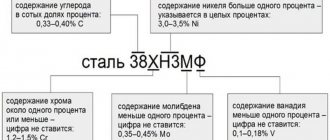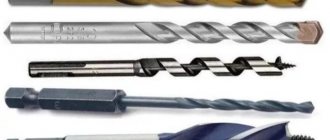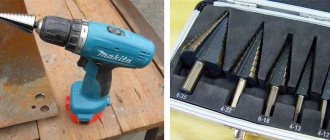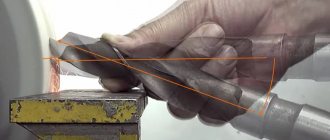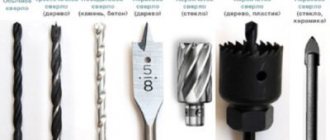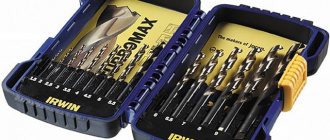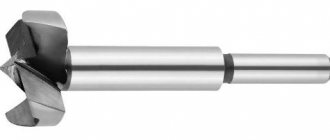Characteristics of HSS steels
HSS steels are divided into three groups:
- Tungsten (T);
- Molybdenum (M);
- High-alloy high-speed steels.
Tungsten steels are practically not used today due to the high cost of tungsten and its shortage. The most common are T1 general purpose steel and T15 vanadium cobalt steel. T15 is used for tools operating under conditions of high temperatures and wear.
Molybdenum group steels have molybdenum as their main alloying element, although some contain equal or greater amounts of tungsten and cobalt. Steels with a high content of vanadium and carbon are resistant to abrasive wear. A series of steels starting from M41 is characterized by high hardness when operating at high temperatures (red resistance). Molybdenum steels are also used in the manufacture of tools operating in “cold” conditions - rolling dies, cutting dies. In such cases, HSS steels are hardened to lower temperatures to improve toughness.
Table of common chemical compositions of HSS steels. Domestic analogues.
| Type | Fatherland analogue | Chemical composition, % | ||||||||
| C | Mn | Si | Cr | V | W | Mo | Co | Ni | ||
| Tungsten HSS steels | ||||||||||
| T1 | P18 | 0,75 | — | — | 4,00 | 1,00 | 18,00 | — | — | — |
| T2 | R18F2 | 0,80 | — | — | 4,00 | 2,00 | 18,00 | — | — | — |
| T4 | R18K5F2 | 0,75 | — | — | 4,00 | 1,00 | 18,00 | — | 5,00 | — |
| T5 | 0,80 | — | — | 4,00 | 2,00 | 18,00 | — | 8,00 | — | |
| T6 | 0,80 | — | — | 4,50 | 1,50 | 20,00 | — | 12,00 | — | |
| T8 | 0,75 | — | — | 4,00 | 2,00 | 14,00 | — | 5,00 | — | |
| T15 | R12F5K5 | 1,50 | — | — | 4,00 | 5,00 | 12,00 | — | 5,00 | — |
| Molybdenum HSS steels | ||||||||||
| M1 | 0,80 | — | — | 4,00 | 1,00 | 1,50 | 8,00 | — | — | |
| M2 | R6M5 | 0,85 | — | — | 4,00 | 2,00 | 6,00 | 5,00 | — | — |
| M3 | R6M5F3 | 1,20 | — | — | 4,00 | 3,00 | 6,00 | 5,00 | — | — |
| M4 | 1,30 | — | — | 4,00 | 4,00 | 5,50 | 4,50 | — | — | |
| M6 | 0,80 | — | — | 4,00 | 2,00 | 4,00 | 5,00 | — | — | |
| M7 | 1,00 | — | — | 4,00 | 2,00 | 1,75 | 8,75 | — | — | |
| M10 | 0,85-1,00 | — | — | 4,00 | 2,00 | — | 8,00 | — | — | |
| M30 | 0,80 | — | — | 4,00 | 1,25 | 2,00 | 8,00 | — | — | |
| M33 | 0,90 | — | — | 4,00 | 1,15 | 1,50 | 9,50 | — | — | |
| M34 | 0,90 | — | — | 4,00 | 2,00 | 2,00 | 8,00 | — | — | |
| M35 | R6M5K5 | 0,82-0,88 | 0,15-0,40 | 0,20-0,45 | 3,75-4,50 | 1,75-2,20 | 5,5-6,75 | 5,00 | 4,5-5,5 | up to 0.30 |
| M36 | 0,80 | — | — | 4,00 | 2,00 | 6,00 | 5,00 | — | — | |
| High alloy HSS steels | ||||||||||
| M41 | R6M3K5F2 | 1,10 | — | — | 4,25 | 2,00 | 6,75 | 3,75 | 5,00 | — |
| M42 | 1,10 | — | — | 3,75 | 1,15 | 1,50 | 9,50 | 8,00 | — | |
| M43 | 1,20 | — | — | 3,75 | 1,60 | 2,75 | 8,00 | 8,25 | — | |
| M44 | 1,15 | — | — | 4,25 | 2,00 | 5,25 | 6,25 | 12,00 | — | |
| M46 | 1,25 | — | — | 4,00 | 3,20 | 2,00 | 8,25 | 8,25 | — | |
| M47 | R2AM9K5 | 1,10 | — | — | 3,75 | 1,25 | 1,50 | 9,50 | 5,00 | — |
| M48 | 1,42-1,52 | 0,15-0,40 | 0,15-0,40 | 3,50-4,00 | 2,75-3,25 | 9,50-10,5 | 0,15-0,40 | 8,00-10,0 | up to 0.30 | |
| M50 | 0,78-0,88 | 0,15-0,45 | 0,20-0,60 | 3,75-4,50 | 0,80-1,25 | up to 0.10 | 3,90-4,75 | — | up to 0.30 | |
| M52 | 0,85-0,95 | 0,15-0,45 | 0,20-0,60 | 3,50-4,30 | 1,65-2,25 | 0,75-1,50 | 4,00-4,90 | — | up to 0.30 | |
| M62 | 1,25-1,35 | 0,15-0,40 | 0,15-0,40 | 3,50-4,00 | 1,80-2,00 | 5,75-6,50 | 10,0-11,0 | — | up to 0.30 | |
Not all analogues may be indicated in the table, since at present there may be a large number of borrowed, non-governed brands.
A cutting tool made with tungsten content (W) will have a very useful quality for the tool - red resistance. It allows tools to maintain a sharp cutting edge and hardness at red-hot temperatures (up to 530°C). Cobalt further increases the red hardness and wear resistance of HSS steels.
M1 . Used for the production of drills for a wide range of applications. M1 steels have lower red resistance than M2 steels, but are less susceptible to impact and are more flexible, making them suitable for general work.
M2 . Standard material for making tools from HSS steels. M2 has good red hardness and retains its cutting edge longer than other HSS steels with lower tungsten content. Typically used for the manufacture of tools for high-performance machine work.
M7 . Used for heavy-duty drills for drilling hard sheet metal. Typically used where flexibility and extended service life are equally important.
M50 . Used to make drill bits that are used for drilling on portable equipment where breakage due to bending is a problem. Does not have the same red resistance as other HSS tungsten steels.
M35 . M35 steels have increased red resistance compared to M2. At the same time, cobalt slightly reduces impact resistance.
M42 . M42 “Super Cobalt” steels have excellent abrasion resistance and good red-hardness. Used for work on viscous and complex materials.
Types of HSS steels
HSS steels come in three categories:
- tungsten (T1-T15);
- molybdenum (M1-M36);
- highly alloyed (M41-M62).
Steels belonging to the tungsten group are not popular nowadays due to the high cost of tungsten.
The most commonly used grade is T1 and the alloy with the addition of cobalt and vanadium T15. T15 steel is used to produce tools that are needed to work at high temperatures and increased wear.
Tungsten steels
Not the most popular variety. This is due to the fact that tungsten is quite rare and expensive. The most common grades of tungsten steel are T1 and T15. The second contains cobalt and vanadium, therefore they are suitable for the production of accessories that have increased requirements for strength and resistance to high temperatures.
Molybdenum HSS drills
The main alloying component of steels in this group is molybdenum. Also in different quantities may contain:
- tungsten,
- cobalt;
- vanadium;
- carbon;
- and other components.
The most widely used are HSS drills made from the following types of molybdenum high-speed steels.
- M1. General purpose tools are produced from this grade of steel (8% molybdenum). These HSS drills are highly flexible and resistant to impact loads. Red fastness is lower than that of analogues.
- M2 (domestic equivalent - P6M5). This is the most common material for the production of HSS drills. The alloy contains 6% tungsten and 5% molybdenum. It has balanced strength, hardness and heat resistance.
- M3 (domestic equivalent - R6M5F3). This alloy also contains 3% vanadium. HSS drills made from this steel have lower abrasive wear.
- M7. The main alloying components are molybdenum (8.75%), vanadium (2%) and tungsten (1.75%). Drills made from this HSS steel are used for drilling hard and thick sheet metals.
- M35 (domestic equivalent - R6M5K5). In addition to tungsten, molybdenum and vanadium, this alloy contains cobalt (5%), as well as small amounts of manganese, silicon and nickel. The advantages of this material are good toughness, excellent grindability, heat and wear resistance. HSS drills made from this alloy are used when processing workpieces made of improved alloy and stainless steels under conditions of increased heating of the cutting edge.
High alloy HSS drills
To produce high-alloy HSS drills (having high impact strength and operating in cold conditions), molybdenum group alloys are used, which are subjected to special heat treatment.
- M47 (domestic analogue - R2AM9K5). Contains large quantities of molybdenum (9%) and cobalt (4.7–5.2%). The alloy has an increased tendency to decarburization and overheating during quenching. Sandability is low. HSS drills made from this alloy are used for machining workpieces made of improved alloy and stainless steels.
- M42. Contains a large amount of cobalt and molybdenum (8 and 9.5%, respectively). HSS drills made from this alloy are characterized by increased red hardness and abrasion resistance. Such tools are used when processing viscous and complex metals.
Legend
The markings of foreign manufacturers do not fully disclose the chemical composition of the HSS steel from which the tool is made. It is assumed that a particular tool is designed for the tasks assigned to it, described in the catalog, and this should be sufficient. The remaining details can be found out either by determining the chemical composition with the same portable metal analyzer or experimentally. In addition, such marking is convenient for an unscrupulous manufacturer, who can make a drill from HSS steel that will not meet the necessary requirements, despite the fact that it is high-speed. Typical markings are described below, by which you can partially determine the material from which the tool is made and its scope of application.
HSS-R (sometimes just HSS) is a designation on drills that have undergone roller rolling and heat treatment. Drills have the lowest durability.
HSS-G is a designation on tools made from HSS steels in which the cutting part is ground with CBN (cubic boron nitride). Tools with increased tool life and less radial runout. HSS-G tools are the most common cutting tools for standard applications.
HSS-E - tools made of HSS steel type M35 with the addition of cobalt. Used for working on viscous and complex materials. You will also find designations such as HSS Co 5 and HSS Co 8 , which indicate the exact cobalt content.
HSS-G TiN is a tool surface coated with titanium nitride. Thanks to this coating, the surface hardness increases by approximately 2300 HV, and the heat resistance increases by up to 600°C.
HSS-G TiAlN is a tool surface coated with titanium-aluminum-nitride. Thanks to this coating, the surface hardness increases by approximately 3000 HV, and the heat resistance increases by up to 900°C.
Differences between HSS and carbide drills
So let's start with the HSS drill.
(adsbygoogle = window.adsbygoogle || []).push({});
HSS drill
HSS (High Speed Steel) is a group that includes steels that are high-speed. Typically, cutting tools are made from these steels. In our case, drills. The steel of this group is high-carbon. Hardness reaches 62-64 HRC.
Advantages over carbide alloys - high-speed steel has greater strength and lower cost.
However, the cutting speed is slower than that of carbide drills.
Drills can be made from tungsten, molybdenum and high-alloy high-speed steels.
Now we will look at the symbols of drills made of high-speed steels and figure out where the drills are applicable and what quality the processed surface will have.
HSS-R - such a drill will have low durability.
HSS-G - This drill has a CBN (cubic boron nitride) polished cutting part. It features increased durability and low radial runout.
HSS-E - cobalt is added to the steel of this drill. Suitable for working with difficult materials.
HSS-G TiN is a drill whose surface is coated with titanium nitride. Which, by the way, serves to increase surface strength.
HSS-G TiAlN is a drill whose surface is coated with titanium-aluminum-nitride.
HSS-E VAP - this tool is useful if you need to process stainless steel.
Drill prices vary. For example, an HSS Co-5 drill can be purchased at a cost of 300 rubles. And purchasing core drills can reduce your budget by 1 thousand rubles. and more.
Carbide drill
The use of carbide drills for processing glass, marble, granite, cast iron, and plastic is the main purpose of the tool. I should immediately note that carbide drills have a high manufacturing cost. That is why they are not very common. Typically, drills do not have high strength and rigidity. They have a tendency to chip.
Such drills are ideal for processing surfaces based on heat-resistant and high-strength metals.
The quality of the processed surface is very high.
The angle of inclination of the front part of the drill is 6-8 degrees. The helical groove has an angle of 20 degrees. If deep holes are drilled, the screw grooves should have an inclination angle of 45 - 60 degrees.
The cost of a drill can also vary, depending on the manufacturer, as well as on the quality of the tool. So, you can buy a carbide drill for a reasonable price, within 400 rubles, or you can buy a drill for 1.5 thousand rubles.
As you and I have seen, drills made from different materials have their own advantages and disadvantages, and at the same time they have completely different costs. Therefore, you should be very careful when choosing drills for workshops and industries.
Types and purposes of HSS drills - markings, parameters, manufacturers
Due to the huge variety of drills available for sale, it is sometimes difficult for the average person to decide on the appropriate option. You should be especially careful when choosing a tool for drilling metal or steel surfaces: mistakes in this case can lead to serious damage. In such situations, experts recommend using HSS metal drills.
Recommendations for selecting HSS drills
The following factors directly influence the choice of HSS drills.
- Grade of processed steel. The choice of tool based on the material of manufacture depends on it.
- Equipment that needs to be equipped with a drill. Buy drill bits with shanks that fit the equipment you have.
- Frequency of use. If you are looking for an HSS drill for one-time jobs, inexpensive models are suitable. If you use the tool often, do not skimp on quality.
You will find detailed information about choosing metal drills for various jobs in this article (put a link to the page with article No. 1).
What is characteristic of HSS steel
The designation "HSS" refers to the high-speed steel used to make cutting tools. We are primarily talking about drills, cutters, dies and taps. According to its characteristics, this high-carbon material is slightly reminiscent of hard alloys, differing from them in greater strength and low cost. The hardness level here can reach 62-64 units (HRC scale).
There are three main types of this steel:
- Tungsten. The high cost of this component explains the fact that tungsten steels are almost completely unavailable.
- Molybdenum. A more common option that contains vanadium and carbon: this gives it high abrasive resistance.
- Highly alloyed.
If the alloy contains tungsten, this gives it “red-hardness”: thanks to it, the tool continues to remain sharp after reaching the temperature at which the material becomes red-hot (approximately + 530 degrees). Cobalt makes alloys even more red-hard and wear-resistant.
How are domestic products labeled?
The marking of high-speed steel differs only in numerical designations (the letter is the same everywhere - “M”).
The number contains an indication of various characteristics of the material:
- M1. This steel is used to make universal products. It has great flexibility and tolerates mechanical stress well. The level of red fastness here is low.
- M2. This material most often serves as the basis for the production of universal drills. Grade M2 has high red resistance, which allows cutting devices to maintain their functionality for a long time.
- M7. This material is mainly used to produce products of considerable power, which must be not only flexible, but also reliable. Metal drills grade M7 are used for drilling hard surfaces of large thickness.
- M50. Drills made from this alloy are typically used in portable applications, where significant bending of the tool is the most common cause of failure. The level of red fastness here is lower compared to other brands.
- M35. The abbreviation HSSE may also be used to refer to this material. Cobalt is present here in greater quantities, which makes the material more red-resistant compared to M2 steel. There is also the opposite effect - because of this, shock loads are not tolerated so well by instruments.
- M42. The proportion of cobalt here is very significant, which explains another name for the alloy - “supercobalt”. Tools made from M42, along with excellent red resistance, withstand abrasion very well. This type of steel is mainly used to produce tools for working with complex, stubborn materials.
As is commonly referred to in the West
A drill made from a similar material in the West is marked as “HSS”. The presence of additional letter indicators helps to form an idea of the alloying method.
Decoding of the designations accepted in the West:
- HSS(R). The least resistant drills made by roller rolling in high heat mode.
- HSS G. The cutting edge here is ground with Borazon. These are the most popular tools due to their high durability. During drilling, the vibration effect is minimal.
- HSS E. The letter “E” makes it clear that the composition contains cobalt. Drills of this type can make holes in complex materials of high viscosity (M35 alloys are labeled this way on the domestic market). In some cases, the manufacturer may be more precise in specifying the percentage of cobalt (for example, HSS-Co 5 or HSS-Co8).
- HSS G TiN. Titanium nitride is used as sputtering in this case. This allows you to make the surface layer of the tool an order of magnitude harder, while increasing the resistance to heat up to + 600 degrees.
- HSS G TiAIN. An indication of the spraying of drills with titanium nitride, which is additionally alloyed with aluminum. In this way, an increase in the strength of the protective layer by almost 3000 HV is achieved. Heat resistance increases by almost 900 degrees.
- HSS E VAP. Designed for drilling stainless steel substrates: chips practically do not stick here. Failures of products in this series occur extremely rarely, and the holes are of very high quality.
- HSS 4241. Devices marked in this way are used to process wood, plastic and aluminum products.
Symbols and markings of HSS steels
To learn more about the material from which the equipment is made, the existing markings on it will help. There are several varieties:
- HSS or HSS R. Drills of this type are considered the most unstable to damage.
- HSS G. The cutting part of the equipment undergoes additional grinding with Borazon. The products are highly durable. They practically do not create beating during operation.
- HSS E. Contains cobalt. Analogues: M35 and HSS-Co. Ideal for drilling complex workpieces and elements.
- HSS G TiN. Coated with titanium nitride. It is characterized by increased strength and heat resistance.
- HSS G TiAIN. The titanium nitride coating is additionally alloyed with aluminum. This approach makes it possible to increase thermal resistance to 900 degrees.
- HSS E VAP. Products made from this alloy are excellent for working with stainless steel.
Recommendations for selection
When choosing a drill for metal, it is advisable to buy products from well-known brands, where the sharpening is at the highest level and the alloy is durable and of high quality:
Ruko. An excellent option in terms of price/quality ratio. It is recommended to pay attention to the TL 3000 models, distinguished by their versatility and titanium coating. These drills are good in cases where medium and long chips are formed during work.
Bosch. A well-known global brand of a variety of hand construction tools and their components. Bosch products are especially appreciated by professional builders.
Haisser. Very powerful drills that are used in industry and everyday life. They are able to withstand the most extreme loads thanks to titanium alloy and special sharpening.
"EKTO". The products of this domestic manufacturer are an order of magnitude cheaper than their Western counterparts, with good quality and service life. Recommended mainly for household use.
Source: oxmetall.ru
Tips for choosing
To choose the right drill, you need to pay attention to important points.
- Study the characteristics of the material and the capabilities of the drill so that the tool meets the requirements of the work being performed.
- Look at the color of the product. It can talk about how the metal was processed.
- steel color indicates that no heat treatment was performed;
- yellow – the metal has been processed, internal stress in the material has been eliminated;
- a bright golden shade indicates the presence of titanium nitride, which increases wear resistance;
- black – the metal is processed with hot steam.
- Study the markings to find out the type of steel, diameter, hardness.
- Find out about the manufacturer, consult with specialists.
- Study the issue of tool sharpening.
Often drills are sold in sets, for example, with different diameters. The question of purchasing such a tool requires an understanding of what purposes the drill is required for and how many options can be used.
HSS steel - features, grades, designations, explanation
The abbreviation HSS, made up of the initial letters of the English words High Speed Steel, denotes a whole group of steels classified as high-speed. Milling cutters, taps, and dies for thread cutting are made from steels of this type. Much less often, such material is used for the production of hacksaw blades and knives.
Alloys of the HSS category refer to high-carbon steels, some grades of which may contain significant amounts of tungsten. The hardness of a tool made from this type of steel can be in the range of 62–64 units on the HRC scale.
End mill made of HSS-Co8 steel is capable of processing material with a tensile strength of up to 1100N/mm2
Tools made from HSS steels, when compared with carbide steels, are more affordable and have higher strength, which allows them to be successfully used for interrupted cutting. Meanwhile, processing with their help is allowed at lower cutting speeds when compared with carbide drills.
The composition of high-speed steels, which foreign manufacturers call HSS alloys, has been constantly improved. So, from the end of the 19th century, a significant amount of tungsten began to be added to such steels (up to 18%), and from 1912 cobalt began to appear in these alloys. It was only in 1930 that molybdenum was included in HSS steels.
What is HSS steel
The abbreviation HSS is derived from the English High Speed Steel - “high-speed steel”.
It is used in the production of various tools for working with metal products. For production, the classical method of casting into ingots followed by rolling and forging is used. The powder method is also used - spraying a stream of liquid steel with nitrogen. HSS alloys belong to the high carbon group, some grades of which contain a certain amount of tungsten. The hardness of tools made from this material corresponds to 62-64 units on the HRC scale.
Products made from high-speed steel have increased strength and are in an affordable price segment.
How do HSS drills differ from carbide models?
First of all, HSS drills differ from carbide drills in their material manufacturing technology.
- High-speed steel is produced by adding tungsten, chromium, molybdenum and other components to carbon steel. The material of HSS drills is highly durable.
- Carbide is a composite material made using powder metallurgy technology. It consists of micron-sized particles. The main component is tungsten carbide. Additional ones include titanium carbide, tantalum carbide, etc.
Carbide tools from HSS drills are characterized by higher hardness and heat resistance. However, hard alloys have lower strength. They are afraid of vibrations and force loads. This does not allow the use of carbide drills for intermittent machining of workpieces at high speeds.
Due to the complex manufacturing technology, carbide tools are expensive. Prices for drills made of high-speed steel are much lower.
Main characteristics and brands
Depending on their composition, HSS steels are divided into three categories:
- with a high content of tungsten (T);
- molybdenum (M);
- highly doped group.
Chemical composition of tungsten HSS steels
Due to the high cost and shortage of tungsten, steels with a high tungsten content are used quite rarely in our time. The most common steels in this group are the general purpose alloy T1 and the steel alloy T15 containing vanadium and cobalt. The latter is used, in particular, for the manufacture of products that must be highly resistant to wear and high temperatures.
Chemical composition and characteristics
Depending on the alloying elements, HSS steels are divided into three main groups:
- T – high tungsten content.
- M – molybdenum is used for alloying.
- Highly doped group.
Analogues of domestic steel grades are R18, R6M5 and other R alloys, widely used for the manufacture of tools.
HSS steels with high tungsten content are rarely used due to their high cost. The most widely used grades are T1 and T15, the first refers to general-purpose alloys, the second, in addition to tungsten, contains vanadium and cobalt, which provides high resistance to wear and operation at high temperatures.
Group M steels are more affordable and, accordingly, more common in modern metalworking. In addition to molybdenum, vanadium, cobalt and tungsten can be used for alloying, which provides high resistance to abrasive wear. In the manufacture of tools with high requirements for temperature resistance, steel grades starting from M41 are used.
Hot hardness
When using cutting devices during operation, heat is constantly released, and about 80% is spent on heating the tool. The temperature of the cutting edge rises and the material is tempered, which entails a decrease in its hardness. Nevertheless, high-speed steel retains its performance even when heated to 500-600°C.
Red fastness
An indicator that takes into account the time period during which steel can withstand elevated temperatures without changing its performance characteristics. An overestimated friction index leads to heating of the metal, which causes changes in the crystal lattice. As a result, some properties of high-speed steel change significantly.
Fracture Resistance
The material used for the manufacture of cutting tools must have high mechanical properties - resistance to brittle fracture. The high strength of the alloy provides the cutting device with resistance to high force, feed and depth of cut, which in turn leads to increased productivity of the process.
Legend
Deciphering the chemical composition of steels classified as HSS is difficult, since their designation does not contain any detailed data. As a rule, catalogs for tools made from steels of this category contain information about the materials for which they can be used. In order to relatively accurately determine the chemical composition of HSS steels, it is necessary to use special equipment or solve this issue experimentally.
Most likely, this is a German analogue of high-speed steel HSS M2
Knowledge of the following information helps to better understand the characteristics and material of the tool on which the HSS marking is applied.
The letter R is often added to this abbreviation. These are drills that are characterized by the least durability. They undergo roller rolling and heat treatment.
This designation is applied to drills whose cutting part is ground using Borazon (CBN). HSS G tools are the most common and are distinguished by their increased durability. In addition, a metal drill on which such a designation is applied creates the least runout when processing with it.
HSS with letter E
This designation indicates that the material used to manufacture the product contains cobalt. Tools with the HSSE designation are ideal for machining difficult materials and materials with high viscosity. As mentioned above, an analogue of the HSSE designation is the M35 marking. There are also international analogues of the HSSE designation (HSS-Co5 and HSS-Co8), which can be used to accurately determine how much cobalt is contained in the steel alloy.
Steel of this grade is extremely difficult to cut with a grinder
This designation indicates that the surface of the tool is coated with titanium nitride. Due to this, both the hardness of the surface layer of the product increases (by approximately 2300 HV) and its heat resistance (up to 600°).
The surface of the tool with this designation is coated with titanium nitride alloyed with aluminum. Thanks to this coating, the hardness of the surface layer of such a drill increases by approximately 3000 HV, and the thermal resistance by 900°.
Products with this designation can be used for processing stainless steel. There is less chip sticking to their surface, so they break less often and provide high quality processing.
You can often find tools with the designation HSS 4241, which are used primarily for processing wood, plastic and aluminum products. As for the Super HSS designation, each manufacturer puts into it their own ideas about the quality of the tool.
The video shows a test of a knife made of HSS W18 steel.
Source: met-all.org
Types and markings of HSS drills
The hss drill is an imported analogue of a cutting tool made of high-speed steel. It is produced with different symbols, indicating differences in manufacturing technology and technical characteristics. The designation carries information about the materials with which they work. They can drill, ream and drill holes in steel, cast iron, non-ferrous metals and high-strength alloys using hand tools and various types of equipment equipped with a chuck of the required design.
Types of cutting tools
HSS (the first letters of the English expression High Speed Steel) is high-speed steel, i.e. high-alloy carbon. In addition to iron and carbon, components such as tungsten, molybdenum, cobalt, titanium and others are added to the composition of the metal in certain quantities. In addition, special substances are sprayed onto the surface of the product to increase the strength and heat resistance of the product. Drills made on the basis of HSS steels are divided into 3 groups:
- tungsten;
- molybdenum;
- highly alloyed.
Tungsten cutting tools are available in seven types: T1, T2, T4, T5, T6, T8 and T15. They differ in the content of carbon (from 0.75 to 1.5%), vanadium (from 1 to 5%), tungsten (from 12 to 18%), cobalt (from 5 to 12%), chromium (from 4 to 4. 5 %). Drills made from tungsten steels are used to work with carbon, alloy, corrosion-resistant, and heat-resistant steels.
Molybdenum tools are available in twelve types: M1, M2, M3, M4, M6, M7, M10, M30, M33, M34, M35 and M36. The carbon content in them is from 0.8 to 1.3%. The amount of molybdenum ranges from 4.5 to 9%. HSS drills differ in the content of chromium, vanadium and tungsten. The M35 type drill also contains cobalt and nickel. These additives allow steel to be processed at high speed when the cutting edge is heated.
High-alloy products are available in ten types: M41, M42, M43, M44, M46, M47, M48, M50, M52 and M62. They have a more complex chemical composition. They are subjected to heat treatment, which allows them to be used at low temperatures. They have good impact strength.
Features of heat treatment
The result of high-temperature processing of high-speed steels is a change in the structure of the material to obtain certain physical and mechanical properties required when working with this tool.
Annealing
HSS steel after the rolling and forging process acquires increased hardness and internal stress. In this regard, the workpieces are preliminarily annealed. Annealing relieves the internal stress of the material, improves machinability and prepares it for hardening.
The annealing process occurs at a temperature of about 850-900°C. However, one should be wary of excessively increasing the temperature and duration of exposure, because this may cause the steel to become more hard. Due to the reduced thermal conductivity of the alloy, heating is carried out slowly and evenly.
The products are loaded into the oven at a temperature of 200-300oC, while subsequent heating is increased at a rate of 150-200o/hour. The process ends with slow cooling: first in an oven to 650 ° C, and then to room temperature in the open air.
To protect against decarburization, annealing is carried out in closed boxes with a neutral environment.
Machine-building plants subject a small number of workpieces to isothermal annealing. They are heated to 880-900oC for a short time, and then transferred to an oven with a temperature not higher than 720-730oC for 2-3 hours. To protect against the appearance of excessive internal stresses, the workpieces are cooled in an oven to 400-450°C and then left in the open air.
Conventional annealing takes longer than the isothermal process. Subsequently, the workpieces undergo mechanical processing, and then the tool undergoes the final heat treatment process - hardening and tempering.
Hardening
Tools made of high-speed steel are hardened at temperatures above 1300°C. After the hardening process, repeated tempering occurs at 550-560°C. This temperature is necessary to dissolve a large number of carbides in the austenite to obtain highly alloyed austenite.
With further cooling, highly alloyed martensite is obtained, which contains large amounts of tungsten, vanadium and chromium. Martensite does not disintegrate when heated to 600°C, which gives high-speed steel red-hardness.
To obtain high red-hardness values, the temperature during hardening must be very high. However, there is a limit, when exceeded, rapid grain growth begins in high-speed steel and melting occurs.
Vacation
Hardened high-speed steel must undergo a tempering process. At a temperature of 550-560°C, a multiple process is carried out at intervals of 1 hour. The purpose of tempering is to transform austenite into martensite. High speed steel goes through two internal processes:
- When heated and subsequently tempered, ground carbide is released from the retained austenite. As a result, the alloying of austenite is reduced, which facilitates easy transformation into martensite.
- During cooling at 100-200°C, martensite is obtained. This also relieves the internal stress that arose during hardening.
Nowadays, factories most often use the process of accelerated tempering of steel, which takes place at elevated temperatures.
Marking
Each manufacturer marks the shank of a metal drill HSS with its diameter and the symbol HSS of the steel from which the tool is made. It can be just an abbreviation of these letters or with the addition of English, several letters, numbers or letters with numbers. They indicate the manufacturing technology, chemical composition and carry information about the materials with which they can work. Foreign manufacturers indicate these properties in catalogs. However, the marking does not reveal the chemical composition of the instrument. They are produced in accordance with the requirements of international standards DIN 338, 340, 1879.
Features of working with HSS drills
When performing a drilling operation with such a drill, it is necessary to observe the cutting modes and technology for performing the work. The basic requirements are as follows:
- select the correct type and diameter in accordance with the metal being processed;
- correctly select drilling modes (spindle speed, cutting speed);
- install at an angle of 90° to the metal surface;
- do not hit the surface of the metal when it enters;
- use coolants and media only those recommended by the manufacturer;
- use equipment and tools that have an appropriate device for installing the drill.
The video describes how to work with some types of tools:
We ask those who have worked with HSS drills to share their experience in the comments to the text, and also tell us about the tool used, the equipment used to carry out the drilling operation, and the features of drilling.
Source: wikimetall.ru
HSS steels - features, grades, designations, explanation.
HSS (High Speed Steel) is a general definition of a group of high-speed steels. HSS steel is used to manufacture a large number of different cutting tools. Usually these are drills, taps, cutters.... HSS steels are high carbon and some contain a large proportion of tungsten. Typically, HSS steel tools have a hardness of 62-64 HRC. The main advantage over carbide tools is the durability and lower cost of the tools. Therefore, HSS performs well in interrupted cutting. A limitation of the use of HSS is the low cutting speeds compared to carbide.
Abroad, as well as here, at the end of the 19th century, HSS steels with a high tungsten content (18%) were the first to be used. The first record of the use of cobalt in steels appeared in Germany in 1912. Later, in 1930, molybdenum was introduced into the United States.
HSS-R, HSS-G, HSS-Co, HSS-E — trunk_2007
Regarding the Queen of the Fields Р18GradeCCrMoWVCoР18T1
| 0,73-0,83 | 3,8-4,4 | <1,0 | 17,0-18,5 | 1,0-1,4 | <0,50 |
| 0.65–0.80 | 3.75–4.00 | — | 17.25–18.75 | 0.9–1.3 | — |
In the 70s of the 20th century, due to a shortage of tungsten, high-speed steel grade R18 was almost universally replaced by steel grade R6M5, which in turn was replaced by tungsten-free steel R0M5F1 and R0M2F3.
The designation HSS stands for “High Speed Steel” and generally applies to the entire class of high speed steels. However, in most cases this is the designation for the most widespread steel of this class - P6M5 (M-2; 1.3343; Z85WDCV; HS 6-5-2; F-5613)
| 0,82-0,90 | 3,8-4,4 | 4,8-5,3 | 5,5-6,5 | 1,7-2,1 | <0,50 |
| 0.95 | 4.2 | 5.0 | 6.0 | 2.0 |
GradeCCrMoWVCoР6М5M2
Approximate translation of European names of steels to our GOSTs: HSS - High Speed Steel - high-speed tool steel, analogue of P6M5 (1.3343 - S6-5-2 DIN). HSS-R - rolled tool.
HSS-G - tool steel, analogue of P6M5. G (Grinding) - polished tool.
HSSE, HSS-E, HSS-Co version of HSS-G alloyed with cobalt is usually M35 - tool high-speed steel, analogue of R6M5K5. CHSS-Co8 - tool high-speed steel, analogue of R6M5K8 - M42.
“M42 is a molybdenum series high speed steel alloy wit,h an additional 8% cobalt. It is widely used in metal manufacturing because of its superior red-hardness as compared to more conventional high speed steels, allowing for shorter cycle times in production environments due to higher cutting speeds or from the increase in time between tool changes. M42 is also less prone to chipping when used for interrupted cuts and cost less when compared to the same tool made of carbide. Tools made from cobalt-bearing high speed steels can often be identified by the letters HSS-Co. "
CV - chrome vanadium tool steel.
About HSS-R, Google gives an adequate link exactly 1 - to the section on high-speed steels in the German Wiki. Holy shit.

